The Role of HR Best Practices in Employee Satisfaction Research
VerifiedAdded on 2022/11/10
|12
|2700
|352
Report
AI Summary
This research report investigates the impact of HR best practices on employee satisfaction, employing a mixed-methods approach for data collection. The methodology section details the use of surveys and interviews to gather both quantitative and qualitative data from employees and HR personnel. The research philosophy adopts positivism, utilizing a deductive approach and an explanatory research design to analyze the relationship between HR practices and employee satisfaction. The research strategy involves a survey through questionnaires distributed randomly to employees, supplemented by statistical data analysis using MS-Excel. Ethical considerations, including informed consent and data privacy, are also addressed. The report aims to provide a comprehensive analysis of how HR best practices influence employee satisfaction levels, supported by statistical data assessment tools and adherence to ethical research principles.
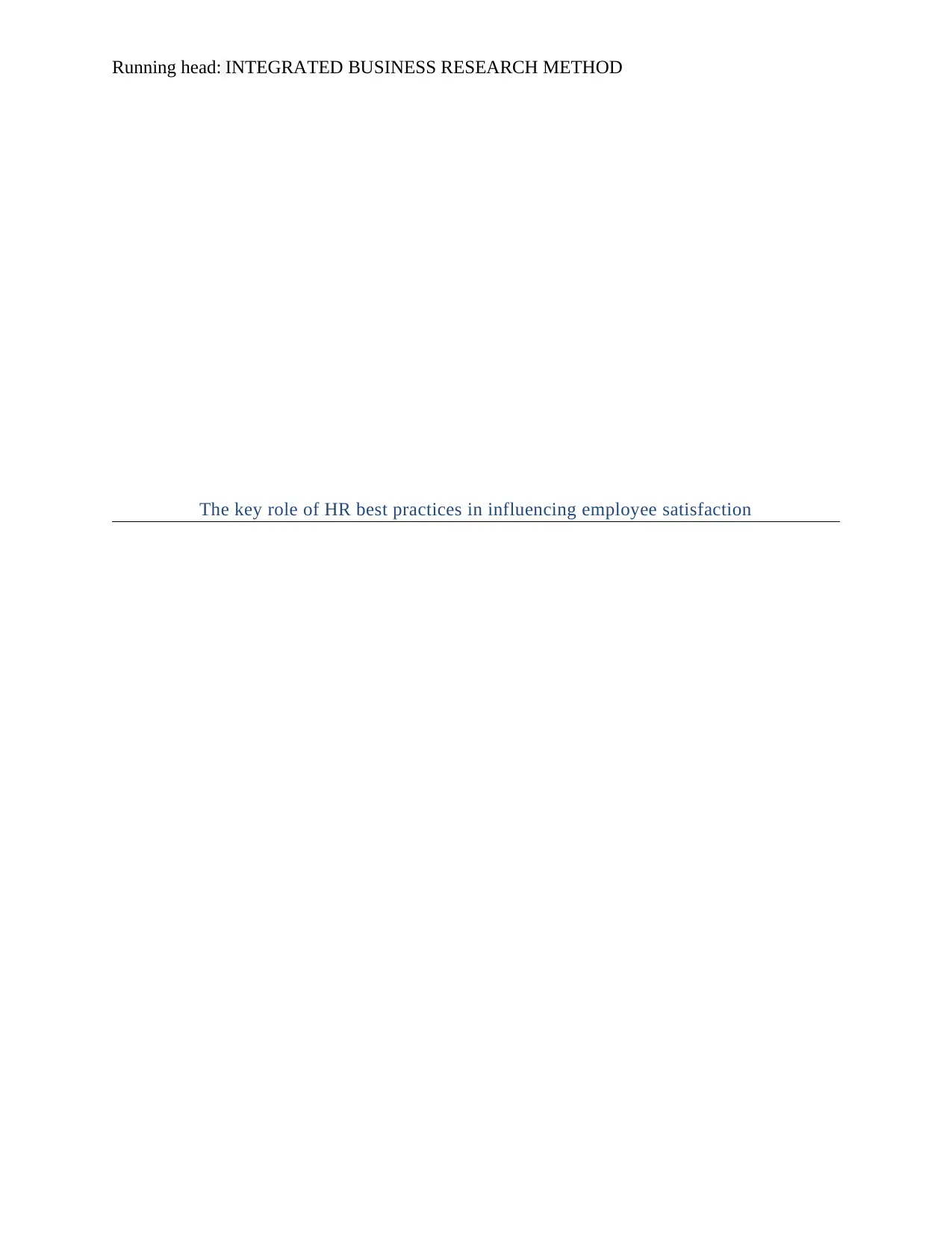
Running head: INTEGRATED BUSINESS RESEARCH METHOD
The key role of HR best practices in influencing employee satisfaction
The key role of HR best practices in influencing employee satisfaction
Paraphrase This Document
Need a fresh take? Get an instant paraphrase of this document with our AI Paraphraser
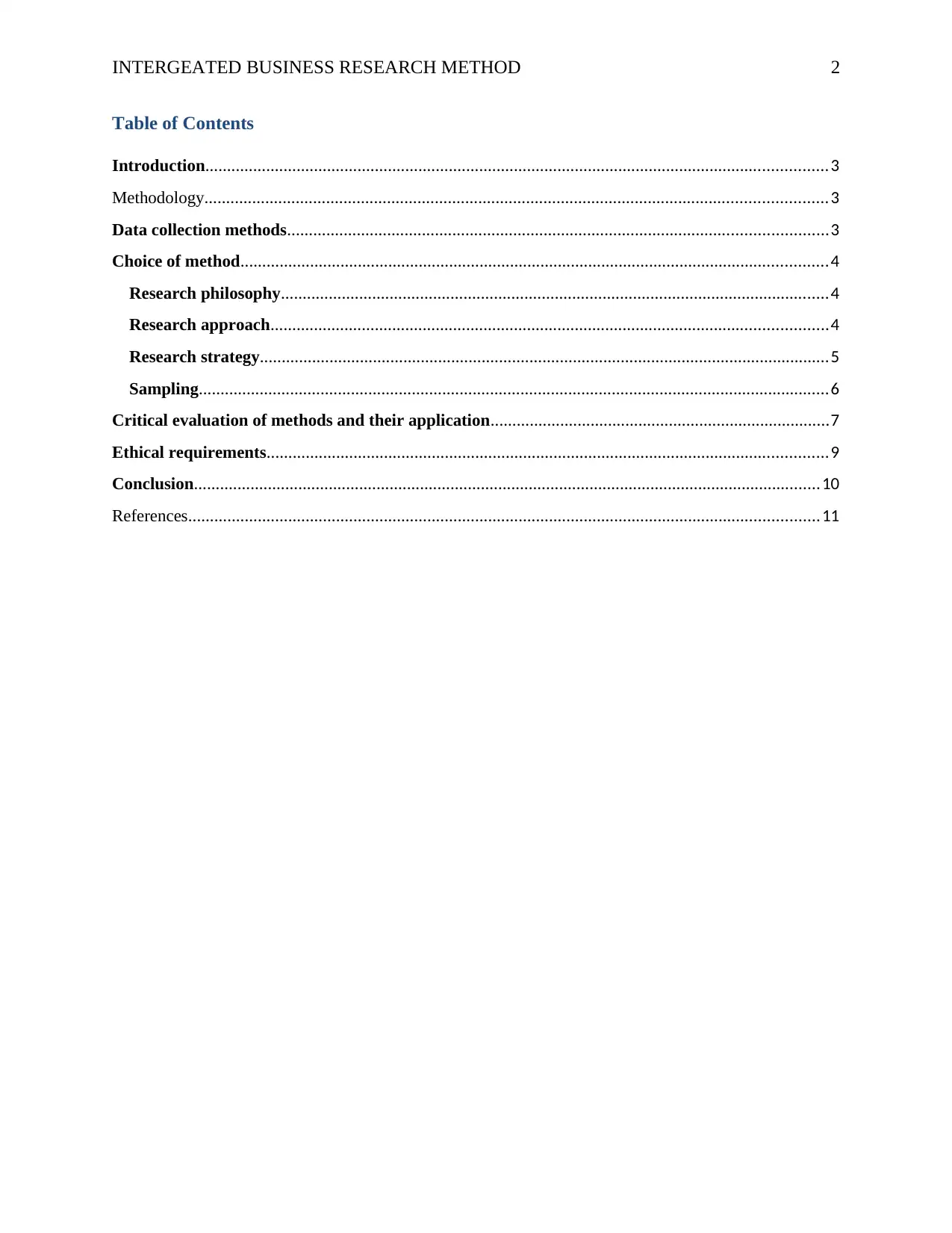
INTERGEATED BUSINESS RESEARCH METHOD 2
Table of Contents
Introduction...............................................................................................................................................3
Methodology...............................................................................................................................................3
Data collection methods............................................................................................................................3
Choice of method.......................................................................................................................................4
Research philosophy..............................................................................................................................4
Research approach................................................................................................................................4
Research strategy...................................................................................................................................5
Sampling.................................................................................................................................................6
Critical evaluation of methods and their application..............................................................................7
Ethical requirements.................................................................................................................................9
Conclusion................................................................................................................................................10
References.................................................................................................................................................11
Table of Contents
Introduction...............................................................................................................................................3
Methodology...............................................................................................................................................3
Data collection methods............................................................................................................................3
Choice of method.......................................................................................................................................4
Research philosophy..............................................................................................................................4
Research approach................................................................................................................................4
Research strategy...................................................................................................................................5
Sampling.................................................................................................................................................6
Critical evaluation of methods and their application..............................................................................7
Ethical requirements.................................................................................................................................9
Conclusion................................................................................................................................................10
References.................................................................................................................................................11
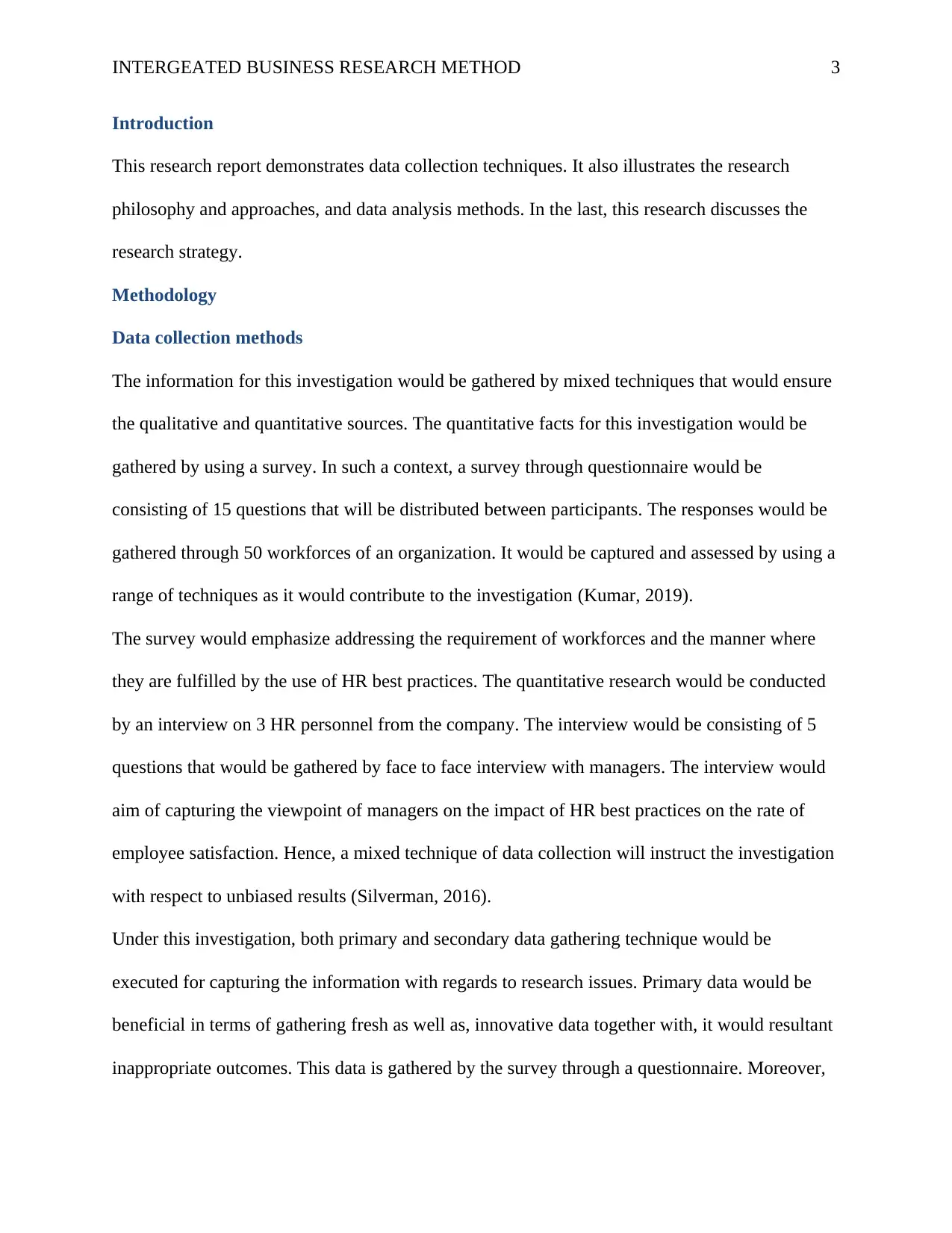
INTERGEATED BUSINESS RESEARCH METHOD 3
Introduction
This research report demonstrates data collection techniques. It also illustrates the research
philosophy and approaches, and data analysis methods. In the last, this research discusses the
research strategy.
Methodology
Data collection methods
The information for this investigation would be gathered by mixed techniques that would ensure
the qualitative and quantitative sources. The quantitative facts for this investigation would be
gathered by using a survey. In such a context, a survey through questionnaire would be
consisting of 15 questions that will be distributed between participants. The responses would be
gathered through 50 workforces of an organization. It would be captured and assessed by using a
range of techniques as it would contribute to the investigation (Kumar, 2019).
The survey would emphasize addressing the requirement of workforces and the manner where
they are fulfilled by the use of HR best practices. The quantitative research would be conducted
by an interview on 3 HR personnel from the company. The interview would be consisting of 5
questions that would be gathered by face to face interview with managers. The interview would
aim of capturing the viewpoint of managers on the impact of HR best practices on the rate of
employee satisfaction. Hence, a mixed technique of data collection will instruct the investigation
with respect to unbiased results (Silverman, 2016).
Under this investigation, both primary and secondary data gathering technique would be
executed for capturing the information with regards to research issues. Primary data would be
beneficial in terms of gathering fresh as well as, innovative data together with, it would resultant
inappropriate outcomes. This data is gathered by the survey through a questionnaire. Moreover,
Introduction
This research report demonstrates data collection techniques. It also illustrates the research
philosophy and approaches, and data analysis methods. In the last, this research discusses the
research strategy.
Methodology
Data collection methods
The information for this investigation would be gathered by mixed techniques that would ensure
the qualitative and quantitative sources. The quantitative facts for this investigation would be
gathered by using a survey. In such a context, a survey through questionnaire would be
consisting of 15 questions that will be distributed between participants. The responses would be
gathered through 50 workforces of an organization. It would be captured and assessed by using a
range of techniques as it would contribute to the investigation (Kumar, 2019).
The survey would emphasize addressing the requirement of workforces and the manner where
they are fulfilled by the use of HR best practices. The quantitative research would be conducted
by an interview on 3 HR personnel from the company. The interview would be consisting of 5
questions that would be gathered by face to face interview with managers. The interview would
aim of capturing the viewpoint of managers on the impact of HR best practices on the rate of
employee satisfaction. Hence, a mixed technique of data collection will instruct the investigation
with respect to unbiased results (Silverman, 2016).
Under this investigation, both primary and secondary data gathering technique would be
executed for capturing the information with regards to research issues. Primary data would be
beneficial in terms of gathering fresh as well as, innovative data together with, it would resultant
inappropriate outcomes. This data is gathered by the survey through a questionnaire. Moreover,
⊘ This is a preview!⊘
Do you want full access?
Subscribe today to unlock all pages.

Trusted by 1+ million students worldwide
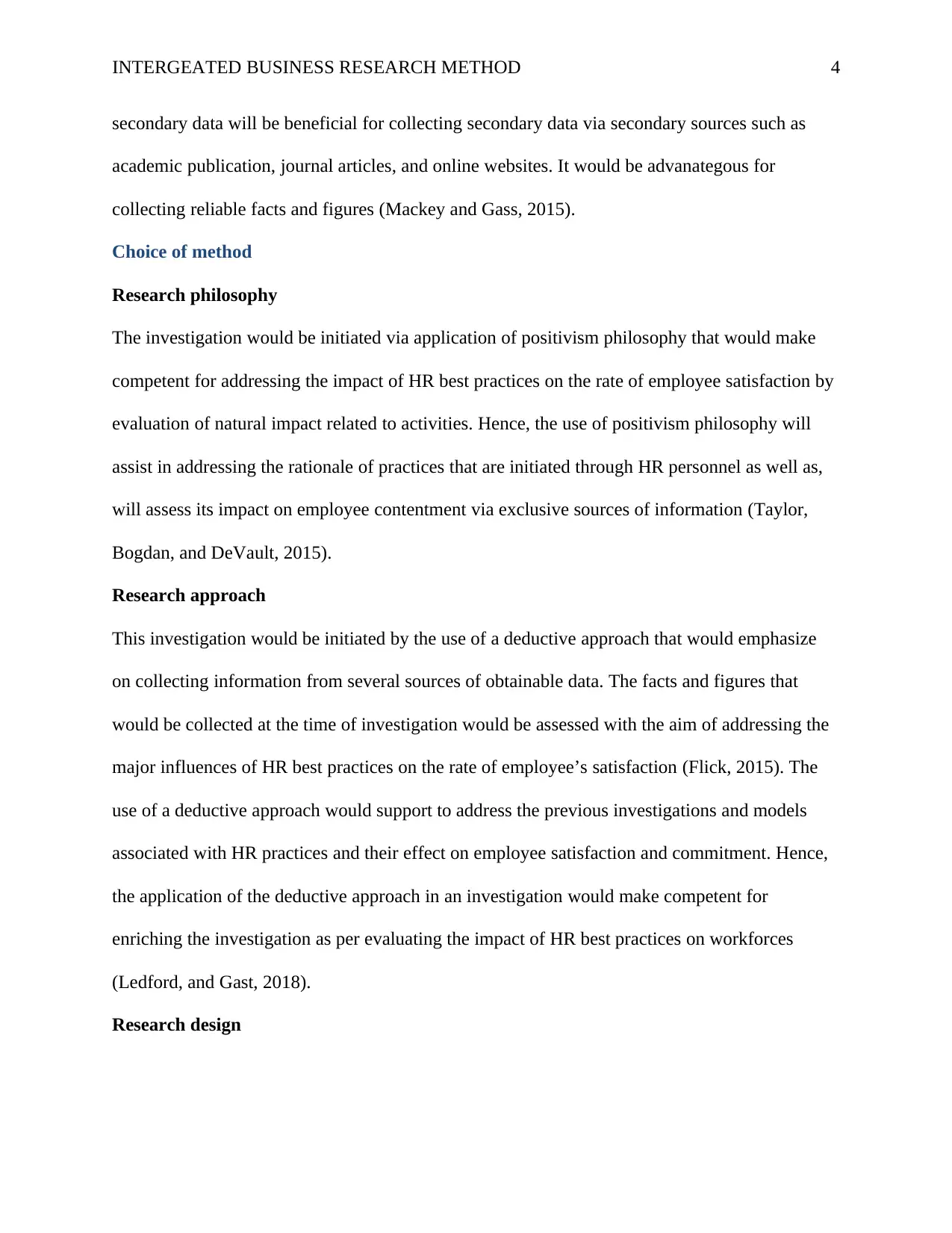
INTERGEATED BUSINESS RESEARCH METHOD 4
secondary data will be beneficial for collecting secondary data via secondary sources such as
academic publication, journal articles, and online websites. It would be advanategous for
collecting reliable facts and figures (Mackey and Gass, 2015).
Choice of method
Research philosophy
The investigation would be initiated via application of positivism philosophy that would make
competent for addressing the impact of HR best practices on the rate of employee satisfaction by
evaluation of natural impact related to activities. Hence, the use of positivism philosophy will
assist in addressing the rationale of practices that are initiated through HR personnel as well as,
will assess its impact on employee contentment via exclusive sources of information (Taylor,
Bogdan, and DeVault, 2015).
Research approach
This investigation would be initiated by the use of a deductive approach that would emphasize
on collecting information from several sources of obtainable data. The facts and figures that
would be collected at the time of investigation would be assessed with the aim of addressing the
major influences of HR best practices on the rate of employee’s satisfaction (Flick, 2015). The
use of a deductive approach would support to address the previous investigations and models
associated with HR practices and their effect on employee satisfaction and commitment. Hence,
the application of the deductive approach in an investigation would make competent for
enriching the investigation as per evaluating the impact of HR best practices on workforces
(Ledford, and Gast, 2018).
Research design
secondary data will be beneficial for collecting secondary data via secondary sources such as
academic publication, journal articles, and online websites. It would be advanategous for
collecting reliable facts and figures (Mackey and Gass, 2015).
Choice of method
Research philosophy
The investigation would be initiated via application of positivism philosophy that would make
competent for addressing the impact of HR best practices on the rate of employee satisfaction by
evaluation of natural impact related to activities. Hence, the use of positivism philosophy will
assist in addressing the rationale of practices that are initiated through HR personnel as well as,
will assess its impact on employee contentment via exclusive sources of information (Taylor,
Bogdan, and DeVault, 2015).
Research approach
This investigation would be initiated by the use of a deductive approach that would emphasize
on collecting information from several sources of obtainable data. The facts and figures that
would be collected at the time of investigation would be assessed with the aim of addressing the
major influences of HR best practices on the rate of employee’s satisfaction (Flick, 2015). The
use of a deductive approach would support to address the previous investigations and models
associated with HR practices and their effect on employee satisfaction and commitment. Hence,
the application of the deductive approach in an investigation would make competent for
enriching the investigation as per evaluating the impact of HR best practices on workforces
(Ledford, and Gast, 2018).
Research design
Paraphrase This Document
Need a fresh take? Get an instant paraphrase of this document with our AI Paraphraser
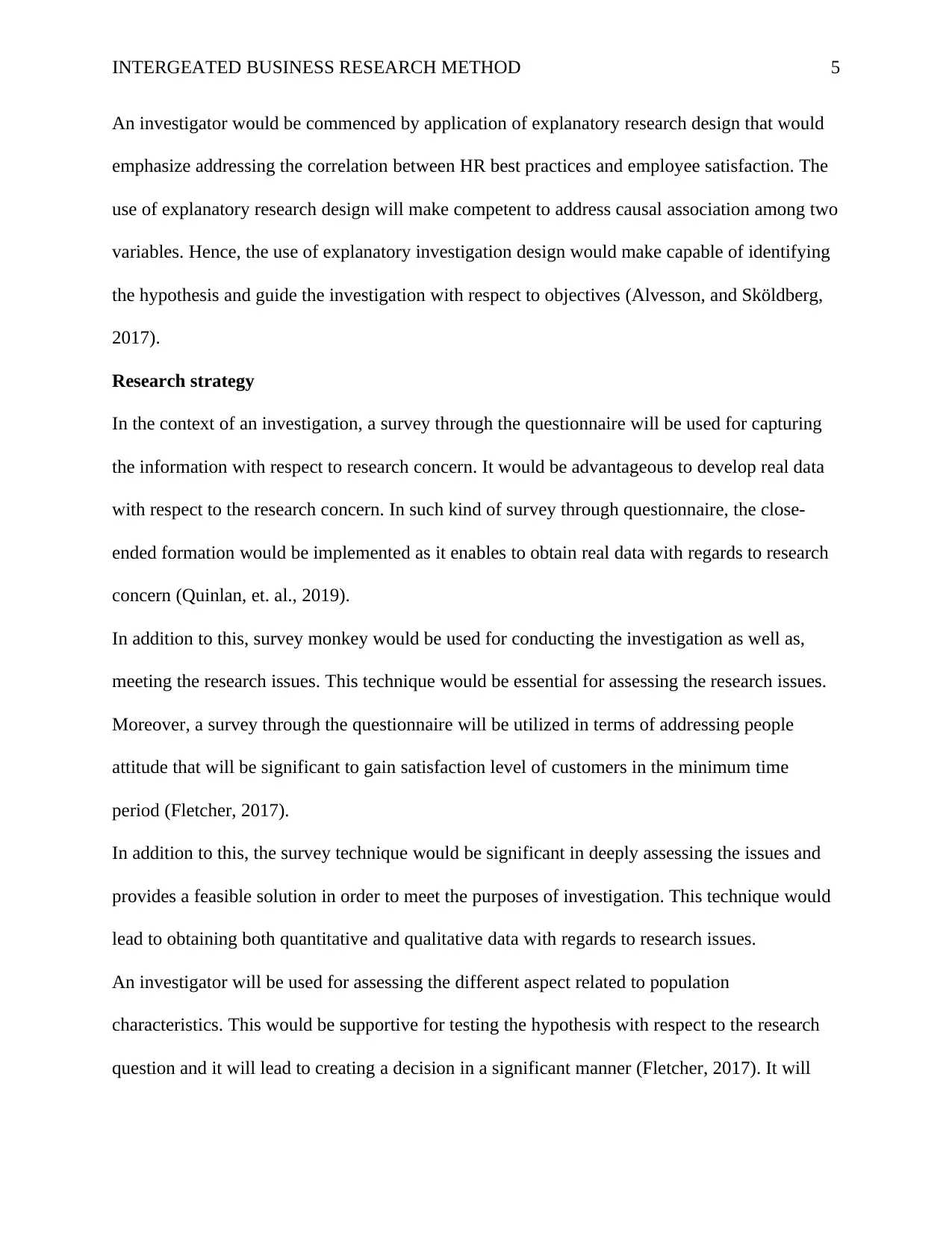
INTERGEATED BUSINESS RESEARCH METHOD 5
An investigator would be commenced by application of explanatory research design that would
emphasize addressing the correlation between HR best practices and employee satisfaction. The
use of explanatory research design will make competent to address causal association among two
variables. Hence, the use of explanatory investigation design would make capable of identifying
the hypothesis and guide the investigation with respect to objectives (Alvesson, and Sköldberg,
2017).
Research strategy
In the context of an investigation, a survey through the questionnaire will be used for capturing
the information with respect to research concern. It would be advantageous to develop real data
with respect to the research concern. In such kind of survey through questionnaire, the close-
ended formation would be implemented as it enables to obtain real data with regards to research
concern (Quinlan, et. al., 2019).
In addition to this, survey monkey would be used for conducting the investigation as well as,
meeting the research issues. This technique would be essential for assessing the research issues.
Moreover, a survey through the questionnaire will be utilized in terms of addressing people
attitude that will be significant to gain satisfaction level of customers in the minimum time
period (Fletcher, 2017).
In addition to this, the survey technique would be significant in deeply assessing the issues and
provides a feasible solution in order to meet the purposes of investigation. This technique would
lead to obtaining both quantitative and qualitative data with regards to research issues.
An investigator will be used for assessing the different aspect related to population
characteristics. This would be supportive for testing the hypothesis with respect to the research
question and it will lead to creating a decision in a significant manner (Fletcher, 2017). It will
An investigator would be commenced by application of explanatory research design that would
emphasize addressing the correlation between HR best practices and employee satisfaction. The
use of explanatory research design will make competent to address causal association among two
variables. Hence, the use of explanatory investigation design would make capable of identifying
the hypothesis and guide the investigation with respect to objectives (Alvesson, and Sköldberg,
2017).
Research strategy
In the context of an investigation, a survey through the questionnaire will be used for capturing
the information with respect to research concern. It would be advantageous to develop real data
with respect to the research concern. In such kind of survey through questionnaire, the close-
ended formation would be implemented as it enables to obtain real data with regards to research
concern (Quinlan, et. al., 2019).
In addition to this, survey monkey would be used for conducting the investigation as well as,
meeting the research issues. This technique would be essential for assessing the research issues.
Moreover, a survey through the questionnaire will be utilized in terms of addressing people
attitude that will be significant to gain satisfaction level of customers in the minimum time
period (Fletcher, 2017).
In addition to this, the survey technique would be significant in deeply assessing the issues and
provides a feasible solution in order to meet the purposes of investigation. This technique would
lead to obtaining both quantitative and qualitative data with regards to research issues.
An investigator will be used for assessing the different aspect related to population
characteristics. This would be supportive for testing the hypothesis with respect to the research
question and it will lead to creating a decision in a significant manner (Fletcher, 2017). It will
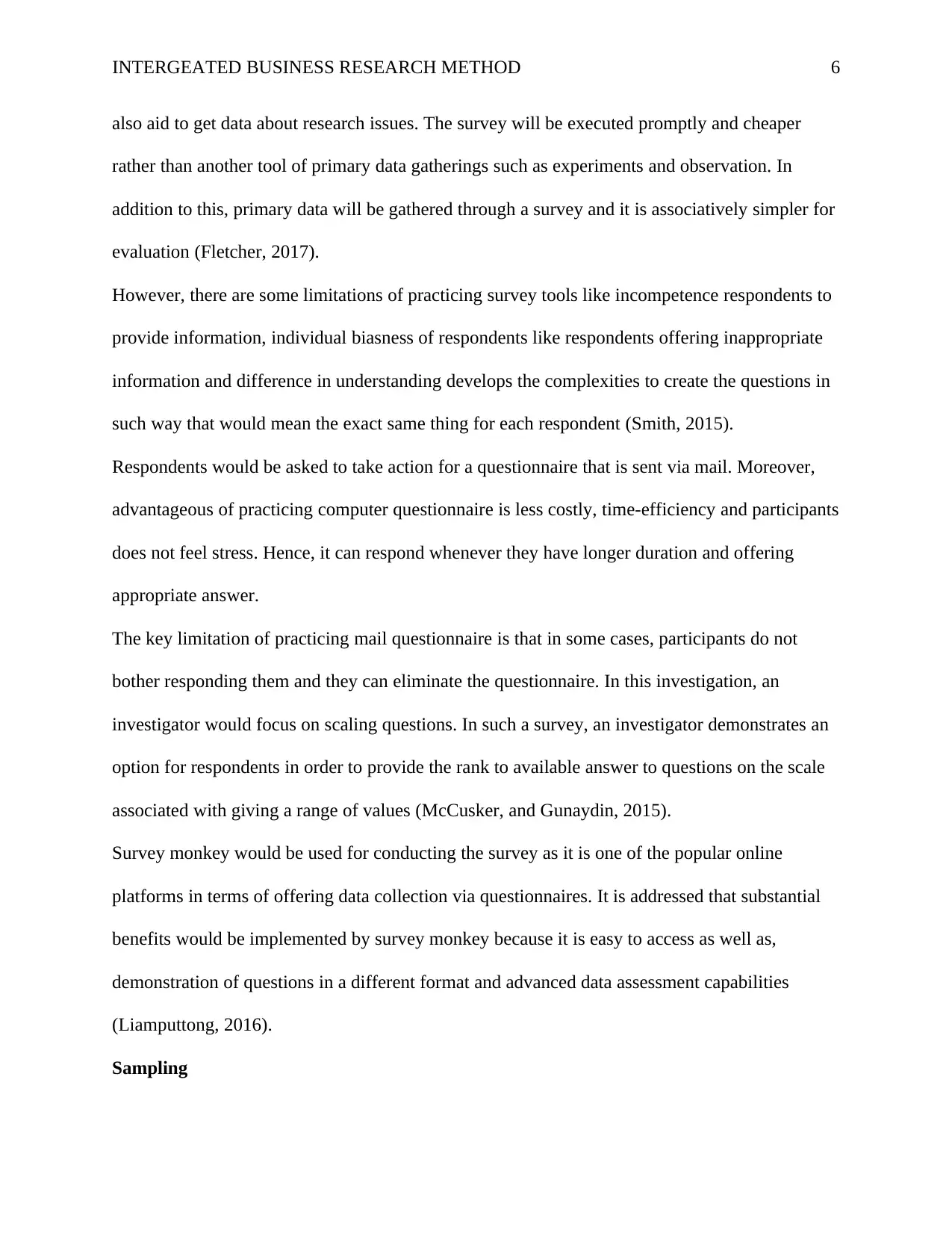
INTERGEATED BUSINESS RESEARCH METHOD 6
also aid to get data about research issues. The survey will be executed promptly and cheaper
rather than another tool of primary data gatherings such as experiments and observation. In
addition to this, primary data will be gathered through a survey and it is associatively simpler for
evaluation (Fletcher, 2017).
However, there are some limitations of practicing survey tools like incompetence respondents to
provide information, individual biasness of respondents like respondents offering inappropriate
information and difference in understanding develops the complexities to create the questions in
such way that would mean the exact same thing for each respondent (Smith, 2015).
Respondents would be asked to take action for a questionnaire that is sent via mail. Moreover,
advantageous of practicing computer questionnaire is less costly, time-efficiency and participants
does not feel stress. Hence, it can respond whenever they have longer duration and offering
appropriate answer.
The key limitation of practicing mail questionnaire is that in some cases, participants do not
bother responding them and they can eliminate the questionnaire. In this investigation, an
investigator would focus on scaling questions. In such a survey, an investigator demonstrates an
option for respondents in order to provide the rank to available answer to questions on the scale
associated with giving a range of values (McCusker, and Gunaydin, 2015).
Survey monkey would be used for conducting the survey as it is one of the popular online
platforms in terms of offering data collection via questionnaires. It is addressed that substantial
benefits would be implemented by survey monkey because it is easy to access as well as,
demonstration of questions in a different format and advanced data assessment capabilities
(Liamputtong, 2016).
Sampling
also aid to get data about research issues. The survey will be executed promptly and cheaper
rather than another tool of primary data gatherings such as experiments and observation. In
addition to this, primary data will be gathered through a survey and it is associatively simpler for
evaluation (Fletcher, 2017).
However, there are some limitations of practicing survey tools like incompetence respondents to
provide information, individual biasness of respondents like respondents offering inappropriate
information and difference in understanding develops the complexities to create the questions in
such way that would mean the exact same thing for each respondent (Smith, 2015).
Respondents would be asked to take action for a questionnaire that is sent via mail. Moreover,
advantageous of practicing computer questionnaire is less costly, time-efficiency and participants
does not feel stress. Hence, it can respond whenever they have longer duration and offering
appropriate answer.
The key limitation of practicing mail questionnaire is that in some cases, participants do not
bother responding them and they can eliminate the questionnaire. In this investigation, an
investigator would focus on scaling questions. In such a survey, an investigator demonstrates an
option for respondents in order to provide the rank to available answer to questions on the scale
associated with giving a range of values (McCusker, and Gunaydin, 2015).
Survey monkey would be used for conducting the survey as it is one of the popular online
platforms in terms of offering data collection via questionnaires. It is addressed that substantial
benefits would be implemented by survey monkey because it is easy to access as well as,
demonstration of questions in a different format and advanced data assessment capabilities
(Liamputtong, 2016).
Sampling
⊘ This is a preview!⊘
Do you want full access?
Subscribe today to unlock all pages.

Trusted by 1+ million students worldwide
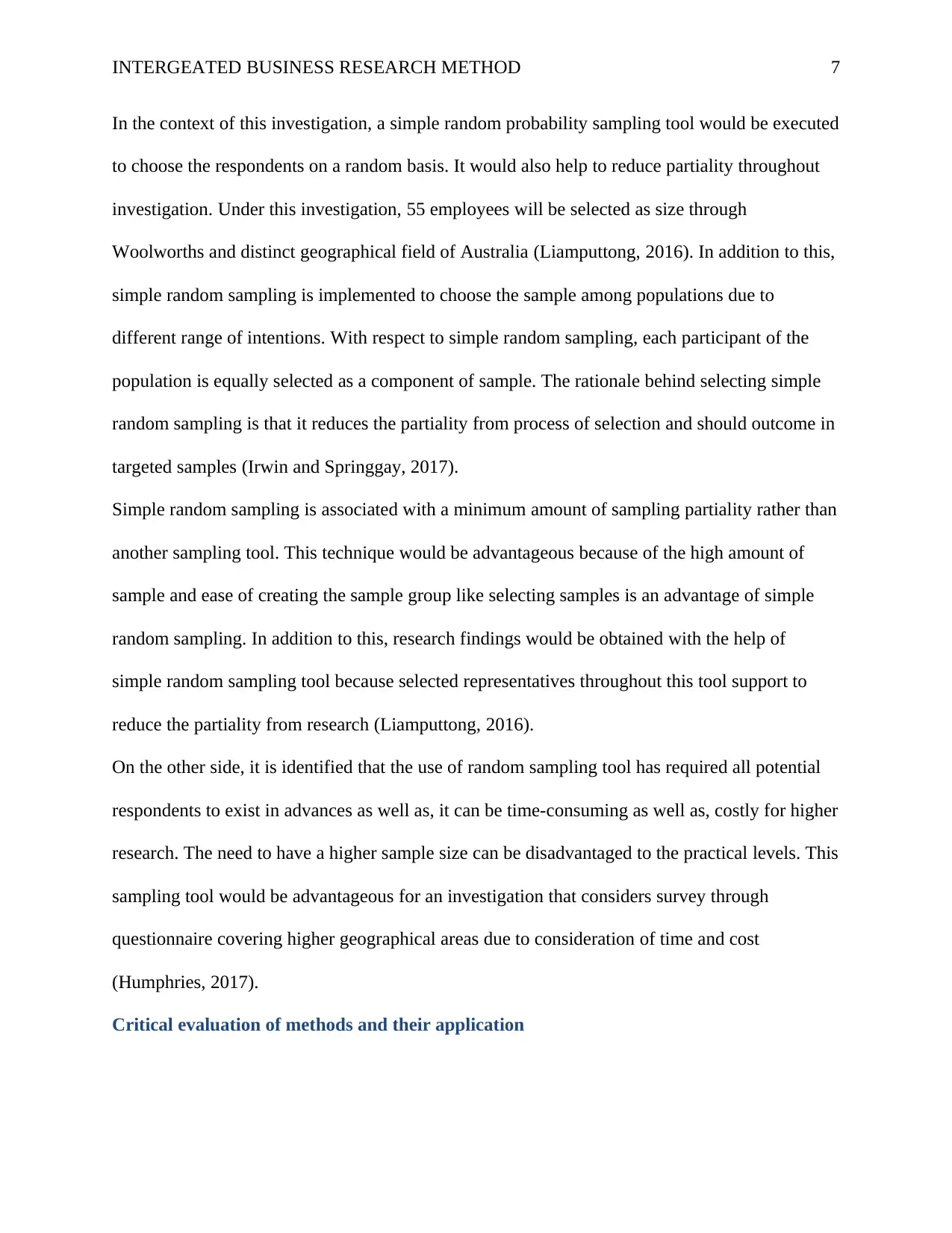
INTERGEATED BUSINESS RESEARCH METHOD 7
In the context of this investigation, a simple random probability sampling tool would be executed
to choose the respondents on a random basis. It would also help to reduce partiality throughout
investigation. Under this investigation, 55 employees will be selected as size through
Woolworths and distinct geographical field of Australia (Liamputtong, 2016). In addition to this,
simple random sampling is implemented to choose the sample among populations due to
different range of intentions. With respect to simple random sampling, each participant of the
population is equally selected as a component of sample. The rationale behind selecting simple
random sampling is that it reduces the partiality from process of selection and should outcome in
targeted samples (Irwin and Springgay, 2017).
Simple random sampling is associated with a minimum amount of sampling partiality rather than
another sampling tool. This technique would be advantageous because of the high amount of
sample and ease of creating the sample group like selecting samples is an advantage of simple
random sampling. In addition to this, research findings would be obtained with the help of
simple random sampling tool because selected representatives throughout this tool support to
reduce the partiality from research (Liamputtong, 2016).
On the other side, it is identified that the use of random sampling tool has required all potential
respondents to exist in advances as well as, it can be time-consuming as well as, costly for higher
research. The need to have a higher sample size can be disadvantaged to the practical levels. This
sampling tool would be advantageous for an investigation that considers survey through
questionnaire covering higher geographical areas due to consideration of time and cost
(Humphries, 2017).
Critical evaluation of methods and their application
In the context of this investigation, a simple random probability sampling tool would be executed
to choose the respondents on a random basis. It would also help to reduce partiality throughout
investigation. Under this investigation, 55 employees will be selected as size through
Woolworths and distinct geographical field of Australia (Liamputtong, 2016). In addition to this,
simple random sampling is implemented to choose the sample among populations due to
different range of intentions. With respect to simple random sampling, each participant of the
population is equally selected as a component of sample. The rationale behind selecting simple
random sampling is that it reduces the partiality from process of selection and should outcome in
targeted samples (Irwin and Springgay, 2017).
Simple random sampling is associated with a minimum amount of sampling partiality rather than
another sampling tool. This technique would be advantageous because of the high amount of
sample and ease of creating the sample group like selecting samples is an advantage of simple
random sampling. In addition to this, research findings would be obtained with the help of
simple random sampling tool because selected representatives throughout this tool support to
reduce the partiality from research (Liamputtong, 2016).
On the other side, it is identified that the use of random sampling tool has required all potential
respondents to exist in advances as well as, it can be time-consuming as well as, costly for higher
research. The need to have a higher sample size can be disadvantaged to the practical levels. This
sampling tool would be advantageous for an investigation that considers survey through
questionnaire covering higher geographical areas due to consideration of time and cost
(Humphries, 2017).
Critical evaluation of methods and their application
Paraphrase This Document
Need a fresh take? Get an instant paraphrase of this document with our AI Paraphraser
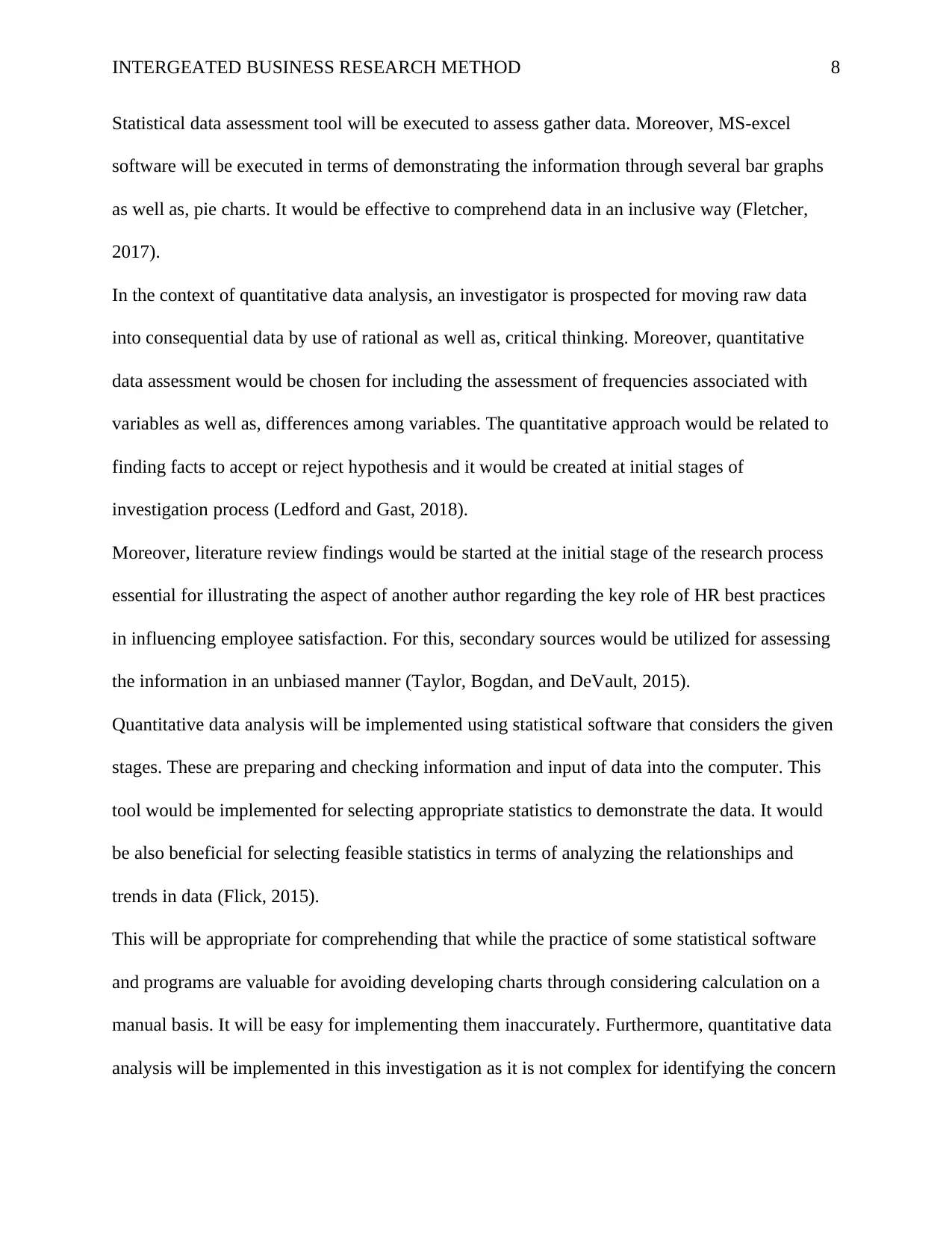
INTERGEATED BUSINESS RESEARCH METHOD 8
Statistical data assessment tool will be executed to assess gather data. Moreover, MS-excel
software will be executed in terms of demonstrating the information through several bar graphs
as well as, pie charts. It would be effective to comprehend data in an inclusive way (Fletcher,
2017).
In the context of quantitative data analysis, an investigator is prospected for moving raw data
into consequential data by use of rational as well as, critical thinking. Moreover, quantitative
data assessment would be chosen for including the assessment of frequencies associated with
variables as well as, differences among variables. The quantitative approach would be related to
finding facts to accept or reject hypothesis and it would be created at initial stages of
investigation process (Ledford and Gast, 2018).
Moreover, literature review findings would be started at the initial stage of the research process
essential for illustrating the aspect of another author regarding the key role of HR best practices
in influencing employee satisfaction. For this, secondary sources would be utilized for assessing
the information in an unbiased manner (Taylor, Bogdan, and DeVault, 2015).
Quantitative data analysis will be implemented using statistical software that considers the given
stages. These are preparing and checking information and input of data into the computer. This
tool would be implemented for selecting appropriate statistics to demonstrate the data. It would
be also beneficial for selecting feasible statistics in terms of analyzing the relationships and
trends in data (Flick, 2015).
This will be appropriate for comprehending that while the practice of some statistical software
and programs are valuable for avoiding developing charts through considering calculation on a
manual basis. It will be easy for implementing them inaccurately. Furthermore, quantitative data
analysis will be implemented in this investigation as it is not complex for identifying the concern
Statistical data assessment tool will be executed to assess gather data. Moreover, MS-excel
software will be executed in terms of demonstrating the information through several bar graphs
as well as, pie charts. It would be effective to comprehend data in an inclusive way (Fletcher,
2017).
In the context of quantitative data analysis, an investigator is prospected for moving raw data
into consequential data by use of rational as well as, critical thinking. Moreover, quantitative
data assessment would be chosen for including the assessment of frequencies associated with
variables as well as, differences among variables. The quantitative approach would be related to
finding facts to accept or reject hypothesis and it would be created at initial stages of
investigation process (Ledford and Gast, 2018).
Moreover, literature review findings would be started at the initial stage of the research process
essential for illustrating the aspect of another author regarding the key role of HR best practices
in influencing employee satisfaction. For this, secondary sources would be utilized for assessing
the information in an unbiased manner (Taylor, Bogdan, and DeVault, 2015).
Quantitative data analysis will be implemented using statistical software that considers the given
stages. These are preparing and checking information and input of data into the computer. This
tool would be implemented for selecting appropriate statistics to demonstrate the data. It would
be also beneficial for selecting feasible statistics in terms of analyzing the relationships and
trends in data (Flick, 2015).
This will be appropriate for comprehending that while the practice of some statistical software
and programs are valuable for avoiding developing charts through considering calculation on a
manual basis. It will be easy for implementing them inaccurately. Furthermore, quantitative data
analysis will be implemented in this investigation as it is not complex for identifying the concern
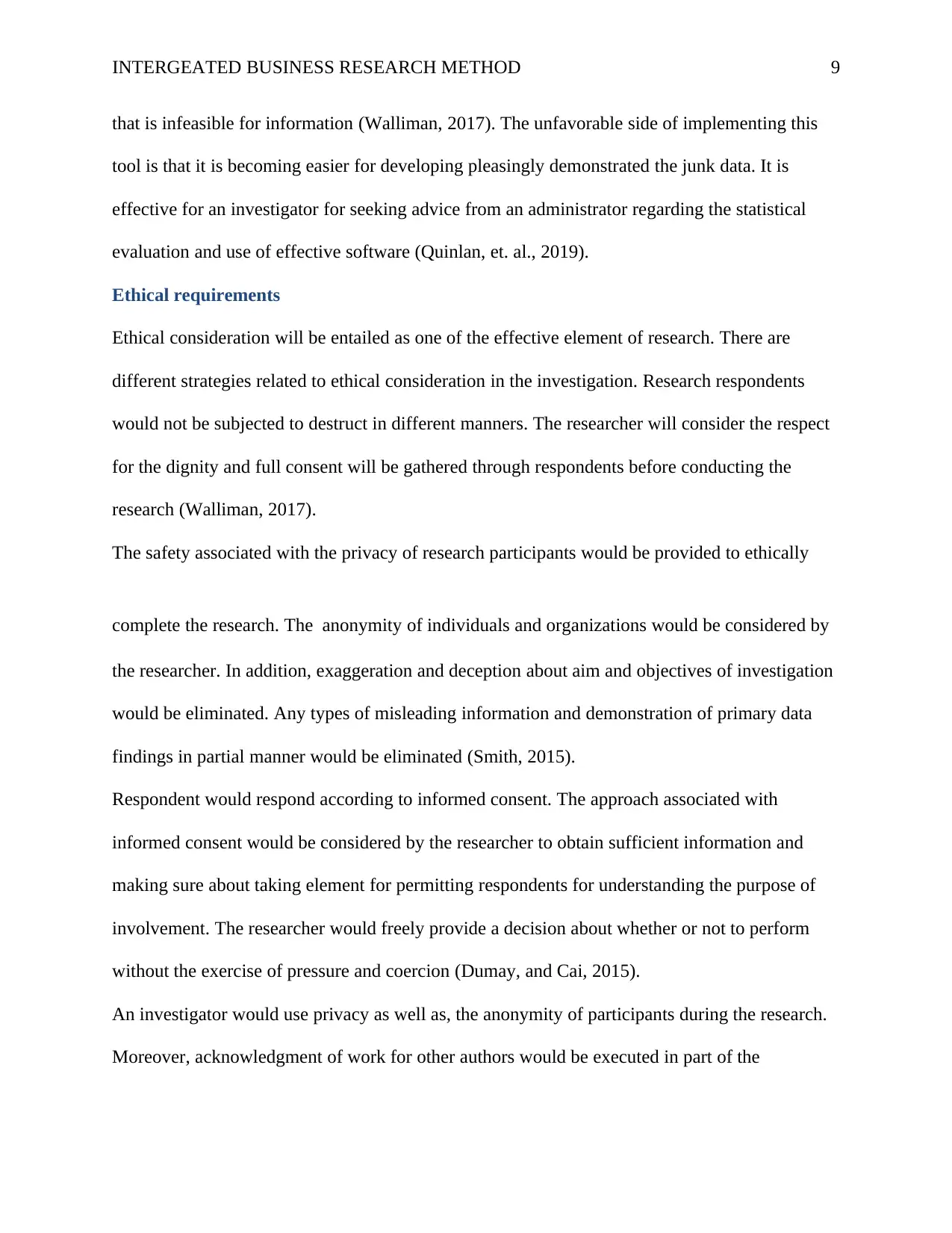
INTERGEATED BUSINESS RESEARCH METHOD 9
that is infeasible for information (Walliman, 2017). The unfavorable side of implementing this
tool is that it is becoming easier for developing pleasingly demonstrated the junk data. It is
effective for an investigator for seeking advice from an administrator regarding the statistical
evaluation and use of effective software (Quinlan, et. al., 2019).
Ethical requirements
Ethical consideration will be entailed as one of the effective element of research. There are
different strategies related to ethical consideration in the investigation. Research respondents
would not be subjected to destruct in different manners. The researcher will consider the respect
for the dignity and full consent will be gathered through respondents before conducting the
research (Walliman, 2017).
The safety associated with the privacy of research participants would be provided to ethically
complete the research. The anonymity of individuals and organizations would be considered by
the researcher. In addition, exaggeration and deception about aim and objectives of investigation
would be eliminated. Any types of misleading information and demonstration of primary data
findings in partial manner would be eliminated (Smith, 2015).
Respondent would respond according to informed consent. The approach associated with
informed consent would be considered by the researcher to obtain sufficient information and
making sure about taking element for permitting respondents for understanding the purpose of
involvement. The researcher would freely provide a decision about whether or not to perform
without the exercise of pressure and coercion (Dumay, and Cai, 2015).
An investigator would use privacy as well as, the anonymity of participants during the research.
Moreover, acknowledgment of work for other authors would be executed in part of the
that is infeasible for information (Walliman, 2017). The unfavorable side of implementing this
tool is that it is becoming easier for developing pleasingly demonstrated the junk data. It is
effective for an investigator for seeking advice from an administrator regarding the statistical
evaluation and use of effective software (Quinlan, et. al., 2019).
Ethical requirements
Ethical consideration will be entailed as one of the effective element of research. There are
different strategies related to ethical consideration in the investigation. Research respondents
would not be subjected to destruct in different manners. The researcher will consider the respect
for the dignity and full consent will be gathered through respondents before conducting the
research (Walliman, 2017).
The safety associated with the privacy of research participants would be provided to ethically
complete the research. The anonymity of individuals and organizations would be considered by
the researcher. In addition, exaggeration and deception about aim and objectives of investigation
would be eliminated. Any types of misleading information and demonstration of primary data
findings in partial manner would be eliminated (Smith, 2015).
Respondent would respond according to informed consent. The approach associated with
informed consent would be considered by the researcher to obtain sufficient information and
making sure about taking element for permitting respondents for understanding the purpose of
involvement. The researcher would freely provide a decision about whether or not to perform
without the exercise of pressure and coercion (Dumay, and Cai, 2015).
An investigator would use privacy as well as, the anonymity of participants during the research.
Moreover, acknowledgment of work for other authors would be executed in part of the
⊘ This is a preview!⊘
Do you want full access?
Subscribe today to unlock all pages.

Trusted by 1+ million students worldwide
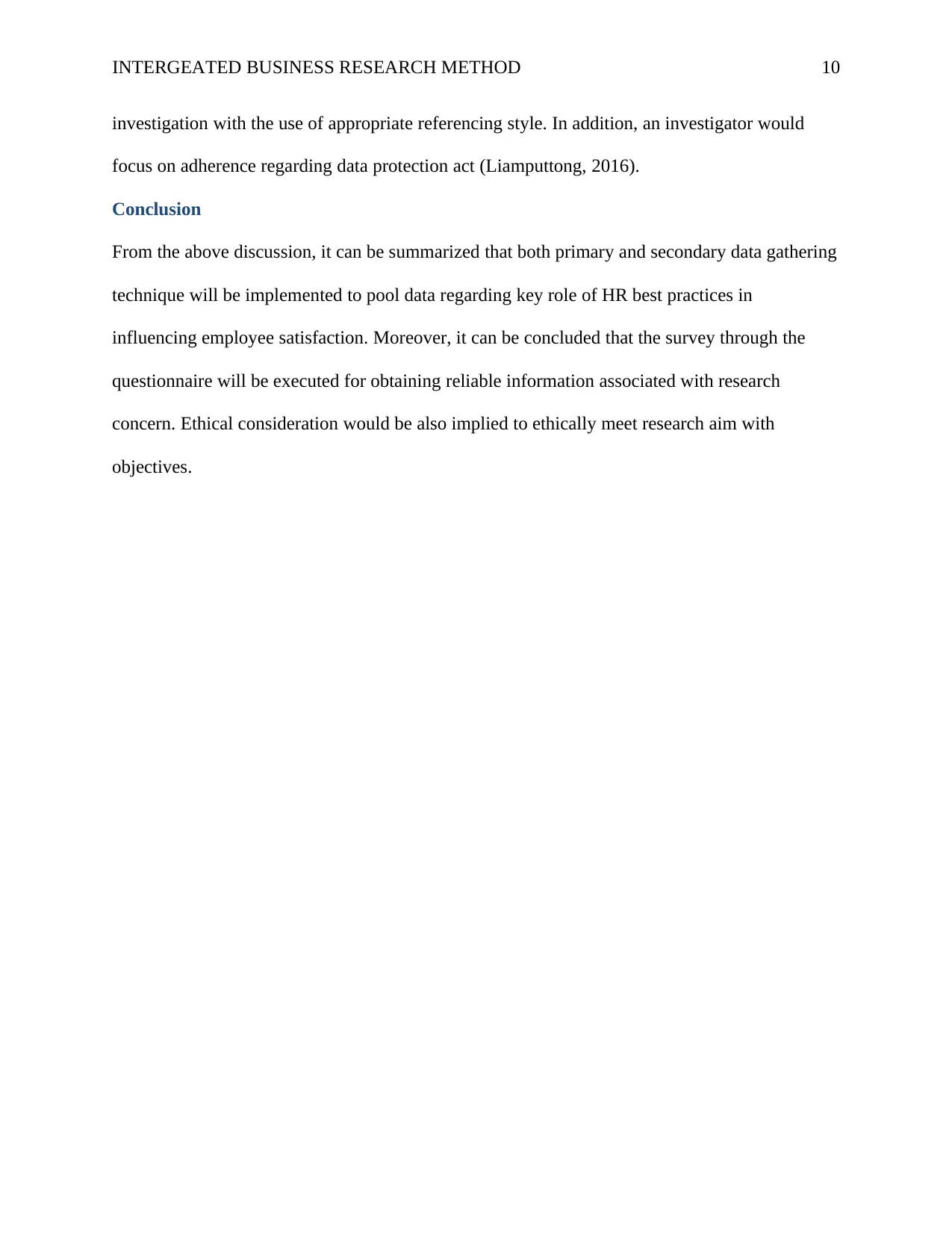
INTERGEATED BUSINESS RESEARCH METHOD 10
investigation with the use of appropriate referencing style. In addition, an investigator would
focus on adherence regarding data protection act (Liamputtong, 2016).
Conclusion
From the above discussion, it can be summarized that both primary and secondary data gathering
technique will be implemented to pool data regarding key role of HR best practices in
influencing employee satisfaction. Moreover, it can be concluded that the survey through the
questionnaire will be executed for obtaining reliable information associated with research
concern. Ethical consideration would be also implied to ethically meet research aim with
objectives.
investigation with the use of appropriate referencing style. In addition, an investigator would
focus on adherence regarding data protection act (Liamputtong, 2016).
Conclusion
From the above discussion, it can be summarized that both primary and secondary data gathering
technique will be implemented to pool data regarding key role of HR best practices in
influencing employee satisfaction. Moreover, it can be concluded that the survey through the
questionnaire will be executed for obtaining reliable information associated with research
concern. Ethical consideration would be also implied to ethically meet research aim with
objectives.
Paraphrase This Document
Need a fresh take? Get an instant paraphrase of this document with our AI Paraphraser
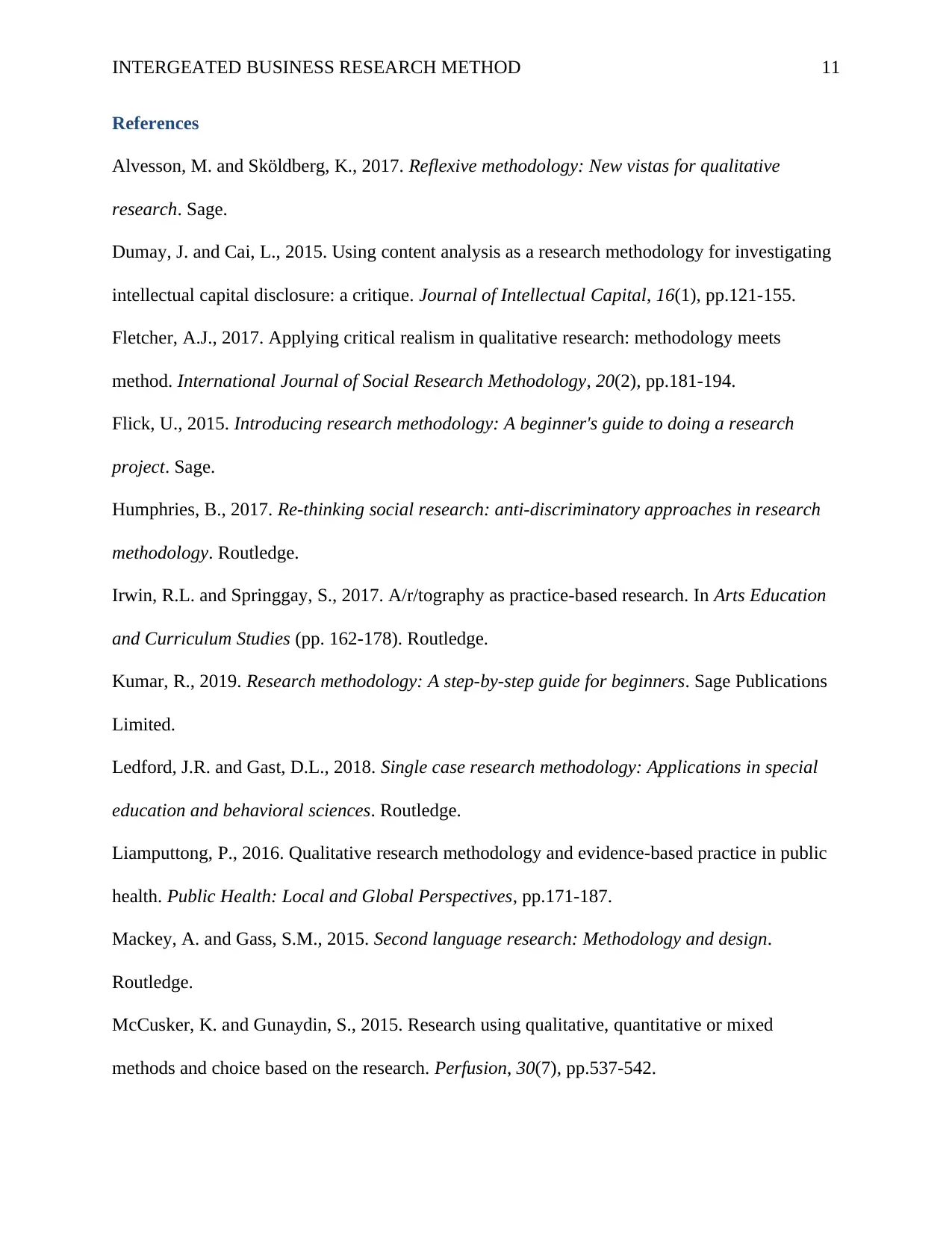
INTERGEATED BUSINESS RESEARCH METHOD 11
References
Alvesson, M. and Sköldberg, K., 2017. Reflexive methodology: New vistas for qualitative
research. Sage.
Dumay, J. and Cai, L., 2015. Using content analysis as a research methodology for investigating
intellectual capital disclosure: a critique. Journal of Intellectual Capital, 16(1), pp.121-155.
Fletcher, A.J., 2017. Applying critical realism in qualitative research: methodology meets
method. International Journal of Social Research Methodology, 20(2), pp.181-194.
Flick, U., 2015. Introducing research methodology: A beginner's guide to doing a research
project. Sage.
Humphries, B., 2017. Re-thinking social research: anti-discriminatory approaches in research
methodology. Routledge.
Irwin, R.L. and Springgay, S., 2017. A/r/tography as practice-based research. In Arts Education
and Curriculum Studies (pp. 162-178). Routledge.
Kumar, R., 2019. Research methodology: A step-by-step guide for beginners. Sage Publications
Limited.
Ledford, J.R. and Gast, D.L., 2018. Single case research methodology: Applications in special
education and behavioral sciences. Routledge.
Liamputtong, P., 2016. Qualitative research methodology and evidence-based practice in public
health. Public Health: Local and Global Perspectives, pp.171-187.
Mackey, A. and Gass, S.M., 2015. Second language research: Methodology and design.
Routledge.
McCusker, K. and Gunaydin, S., 2015. Research using qualitative, quantitative or mixed
methods and choice based on the research. Perfusion, 30(7), pp.537-542.
References
Alvesson, M. and Sköldberg, K., 2017. Reflexive methodology: New vistas for qualitative
research. Sage.
Dumay, J. and Cai, L., 2015. Using content analysis as a research methodology for investigating
intellectual capital disclosure: a critique. Journal of Intellectual Capital, 16(1), pp.121-155.
Fletcher, A.J., 2017. Applying critical realism in qualitative research: methodology meets
method. International Journal of Social Research Methodology, 20(2), pp.181-194.
Flick, U., 2015. Introducing research methodology: A beginner's guide to doing a research
project. Sage.
Humphries, B., 2017. Re-thinking social research: anti-discriminatory approaches in research
methodology. Routledge.
Irwin, R.L. and Springgay, S., 2017. A/r/tography as practice-based research. In Arts Education
and Curriculum Studies (pp. 162-178). Routledge.
Kumar, R., 2019. Research methodology: A step-by-step guide for beginners. Sage Publications
Limited.
Ledford, J.R. and Gast, D.L., 2018. Single case research methodology: Applications in special
education and behavioral sciences. Routledge.
Liamputtong, P., 2016. Qualitative research methodology and evidence-based practice in public
health. Public Health: Local and Global Perspectives, pp.171-187.
Mackey, A. and Gass, S.M., 2015. Second language research: Methodology and design.
Routledge.
McCusker, K. and Gunaydin, S., 2015. Research using qualitative, quantitative or mixed
methods and choice based on the research. Perfusion, 30(7), pp.537-542.
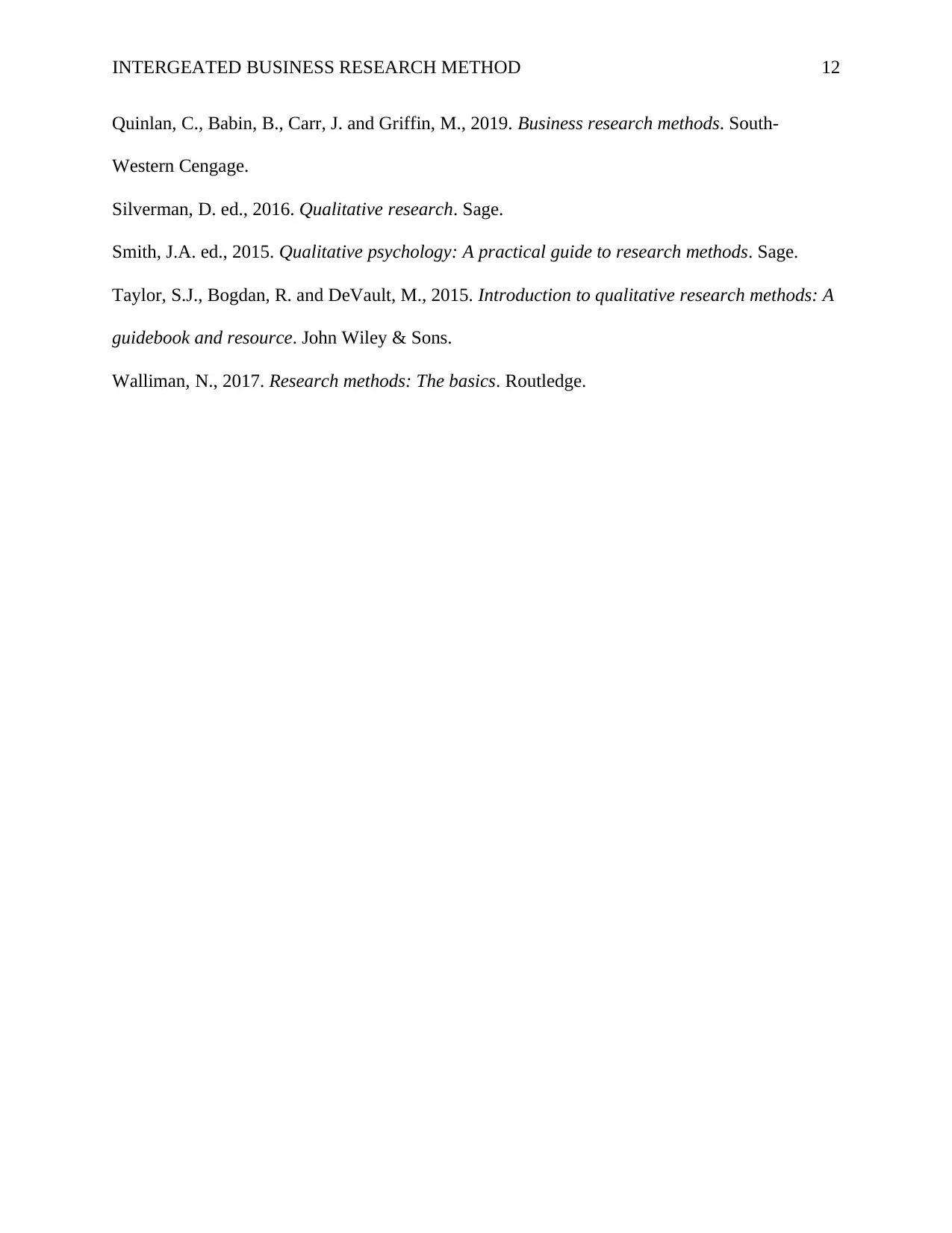
INTERGEATED BUSINESS RESEARCH METHOD 12
Quinlan, C., Babin, B., Carr, J. and Griffin, M., 2019. Business research methods. South-
Western Cengage.
Silverman, D. ed., 2016. Qualitative research. Sage.
Smith, J.A. ed., 2015. Qualitative psychology: A practical guide to research methods. Sage.
Taylor, S.J., Bogdan, R. and DeVault, M., 2015. Introduction to qualitative research methods: A
guidebook and resource. John Wiley & Sons.
Walliman, N., 2017. Research methods: The basics. Routledge.
Quinlan, C., Babin, B., Carr, J. and Griffin, M., 2019. Business research methods. South-
Western Cengage.
Silverman, D. ed., 2016. Qualitative research. Sage.
Smith, J.A. ed., 2015. Qualitative psychology: A practical guide to research methods. Sage.
Taylor, S.J., Bogdan, R. and DeVault, M., 2015. Introduction to qualitative research methods: A
guidebook and resource. John Wiley & Sons.
Walliman, N., 2017. Research methods: The basics. Routledge.
⊘ This is a preview!⊘
Do you want full access?
Subscribe today to unlock all pages.

Trusted by 1+ million students worldwide
1 out of 12
Related Documents
Your All-in-One AI-Powered Toolkit for Academic Success.
+13062052269
info@desklib.com
Available 24*7 on WhatsApp / Email
![[object Object]](/_next/static/media/star-bottom.7253800d.svg)
Unlock your academic potential
Copyright © 2020–2025 A2Z Services. All Rights Reserved. Developed and managed by ZUCOL.




